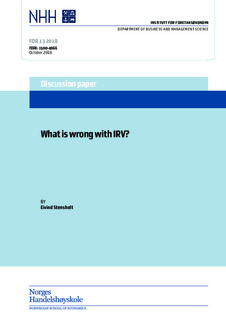What is wrong with IRV?
Working paper

Åpne
Permanent lenke
http://hdl.handle.net/11250/2569297Utgivelsesdato
2018-10-22Metadata
Vis full innførselSamlinger
- Discussion papers (FOR) [566]
Sammendrag
Struggles over the single-seat preferential election method IRV, Instant Runoff Voting, (a.k.a. AV, Alternative Vote or RCV, Ranked-Choice Voting) go on in many arenas: legislatures, courts, websites, and scholarly journals.
Monotonicity failures, i.e. elections (preference distributions) that may allow the startling tactical voting of Pushover or its reverse, has come to the forefront. An analysis of 3-candidate elections concludes that monotonicity failures, while not rare, are hard to predict and risky to exploit; it also explains the scarcity of evidence for effects on election results.
A more unfortunate possibility is the No-Show accident; the number of ballots with preference order XYZ grows beyond a critical size and cause Z to win instead of Y. An analysis concludes that this must happen often enough to justify a modification of the rules.
Pictograms and constellation diagrams are visualization tools that organize the set of possible elections efficiently for the analysis, which obtains explicit classification of elections where Pushover or a No-Show accident may occur or may already have occurred, and of bounds for the number of voters that must be involved.
The analysis takes place in close contact with two frameworks for preferential election methods, one mathematical and one legal/political; these frameworks are themes for two survey sections.